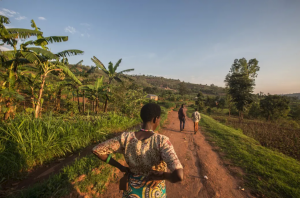I’m not going to interview Invisible Children, in part because I’m a little busy at the moment. But if I did, here’s the questions I’d ask.
Meanwhile, check out these visible women — an incredible Congolese radio collective of bravery, determination and mix tapes.
1. You took in more than $10 million last year. Of that, $3.3 million appears to be sales from IC merchandise. After all of your expenses — including nearly $90,000 in salaries each for your two co-founders and your CEO — and less your liabilities, you are still sitting on more $6.5 million, according to your IRS 990 form.
How exactly do you qualify as a “non-profit”?
(Follow up: How exactly do you sell that many T-shirts?)
2. I’m assuming that the $2.8 million listed on your 990 as being spent overseas is going to the 11,000 war-affected people you say you’re helping. I’m wondering why you’re sitting on nearly twice as much money and what you intend to do with it. (Follow up: How much of that went into your video?)
3. You tell the IRS that: “The organization has developed programs Stateside that focus on advocacy and spreading the message to ‘do more than just watch.’ These initiatives include a biannual film tour, cross-platform media campaigns, and grassroots events.”
How exactly is this more than watching?
4. In that little box on the 990 where you’re supposed to list all of your key employees as well as your five top paid employees and their hours, I see that you only have three names, of men who reportedly work 55 hours a week. Would you consider me for the other apparent two vacancies for jobs with reasonable leisure time? With more than $414,000 in employee expenses, I assume your benefits package is sensational. And I would add a marked note of gender diversity to your lineup, though sadly we’d all still be very white.
5. I have seen from your video that you are aware of maps. So we can’t blame bad geography for this:
Are you aware that the LRA is not currently in Uganda? If not, why not?




I actually thought the video did a good job of showing how the LRA had moved on from Uganda.
On that one, you caught me cribbing from this.
I think this puts what I was getting at quite well:
“Now, of course, it is quite complicated. Their video or message is not evil, maybe not even bad. It is certainly well made. It briefly mentions Kony moving out of Uganda years ago, but still for some reasons continues to focus on Uganda. And it had the same footage of a night commute school jammed with kids that I saw them play on that college campus (cooper union) in 2004. But as everyone is noting, Joseph Kony is a bad man, and if he is even still alive (doubtful), he should be brought to justice. Fine. True. So, what’s wrong with the video? Well, a lot. And I’m even going to ignore the shady financials of IC and the funneling of money to the Ugandan Military which of course deserves scrutiny. I’m also going to leave alone the fact that Invisible Children claimed responsibility for pressuring the US Government into sending 100 troops to Uganda a few months ago while leaving out the information about a large oil deposit being found in the area just prior. And I’ll even leave out the flimsy rationale that there was even a point to making the video in the first place. This is a line they use in the voiceover “He’s changed his tactics, and International support could be removed at any time.” Umm… what? Did anyone suggest that the 100 unarmed US troops would be removed from Uganda? And by “changed his tactics” did you mean “possibly die?” Invisible Children looks like they fictionalized some kind of danger so we have to call our congressmen to keep troops there, thus they needed to make this video urgently. It’s not like those 100 US troops or anyone in the Ugandan Army who is actually trying to hunt Joseph Kony didn’t know his name and needed him to be more famous.”
http://myquaintandquietlife.tumblr.com/post/19039946905/ivan-2012
Great questions. I asked the same questions in this article that I wrote a while ago.
“How Invisible Children Falsely Marketed the LRA Disarmament and Northern Uganda Recovery Act”
http://www.blackstarnews.com/news/122/ARTICLE/6586/2010-06-02.html
You should be ashamed of yourself! Clearly research isn’t your strong point. Maybe you should learn how to read a fiscal report before posting something so mis-informed, and honestly, filled with lies. Seriously, please learn how to read a fiscal report.
“Three middle-class white guys risking their lives to stop a genocidal madman instead of hanging out at home and playing Angry Birds is something you feel needs to be brought down a notch?”
http://invisible.tumblr.com/post/18960441299/movie-director-gives-thoughtful-response
Not lies. Questions. Which are, by nature of their…shall we say genre?… not lies. I would ask any 501(c)3 with $6.5 million in the bank at the end of a fiscal year, and steadily rising streams of revenue over three years, how the whole “non profit” thing works. For example.
I question your premise (or whoever’s your quoting) that these “three middle class white guys” are “risking their lives,” though I understand the heroic narrative to which the appellation appeals, and I would outright reject your premise of genocide, and the notion that “genocidal madman” hangs together as a coherent thought. As I’ve explained many times elsewhere on this blog, I belong to the school of theory that interprets genocide as a rational policy choice of (usually state) actors. And I find it very difficult to ascribe “an intent to destroy in whole or in part” a distinct group of people, exclusive of others, to the LRA’s violence. Its wanton indiscrimination seems in fact to make exactly the opposite point. Which is to say, I’ll concede the “madman” part. Perhaps.
Jina, this whole Kony 2012 circus is just too much for a Ugandan like to me to palate in which ever way you look at it. What I am sure of is that from now on each time I meet a non Ugandan especially from the West, we shall not be short of conversation topics. I will be most likely expected to say something about Idi Amin (Last King of Scotland), my stand on gay rights issues (Anti-Gay bill) and now Joseph Kony (Kony 2012). And yet none of the three issues are of much consequence in my country.
In the meantime I am yet to share coffee with anyone interested in which places to visit while in my country. Why not, when Lonely Planet advised that Uganda is the top tourist destination for 2012?
Best regards my friend.
Well put, my friend. As always.
Thanks Jina! I may interview them so might steal some of this.
Re: Where the LRA is. Of course IC knows! It is the deliberate underplaying of this in the video that confused so many well-meaning teenagers, and I want to figure out if this was because it was a) so clear to the folks who made the movie they didn’t expect confusion, b) a strategic choice not to confuse the audience, esp with the most heartbreaking images coming from Uganda earlier, or c) something else.
My one week later working hypothesis is IC just didn’t expect it to go as hyper viral and thus weren’t prepare to either respond to serious concerns, misguided followers or give tangible action steps. The CEO says something like this today. http://thelede.blogs.nytimes.com/2012/03/15/lessons-learned-from-kony2012/
I quite liked this piece, too, which gets at some of this much more bluntly, zeroing in on one of the “action options” all this raises: “Would the cost of a manhunt across an area the size of, say, Texas, where there is zero infrastructure, save lives or is Kony just rotting in the bush somewhere? I don’t know. Neither does IC.”
Though I have to confess that at this point, I do wish we were talking about other things…
$90,000 doesn’t seem altogether unreasonable to me–compared to salaries of other ngo leaders. Yes, compared to Africans it does–but then, so would say $15,000, for that matter, which “we” all agree would be altogether inadequate.
Fair point, indeed, though “Africans” is rather broad, of course, and I’ve met more than a few who fit the moniker and make more than $15,000… which is to say, the relativity of it all makes these things difficult.
Jina, I’ve been a long time follower and have great respect for your work, and there’s no shortage of good points of discussion around this campaign, but these questions have been answered.
(1) “Non-profit” has nothing to do with the size of your budget, or even salaries. It’s your purpose and corporate structure. If you think their budget is big, you should ask any of the INGOs you have worked with what their budgets are, and how much money they have in cash reserves. No doubt, much more, because it’s considered best practice to ensure “bad fundraising” years don’t disrupt your ability to provide your services to communities in need.
On salaries, no doubt many find that amount to be unsettling, and that’s fine. But it’s also far below market for what similar positions are compensated in other U.S. nonprofits of the same size. Refer to Guidestar’s nonprofit compensation report for results from a nationwide survey. And non-profits (once again, Kirkpatrick), are legally permitted to spend up to 15% of their budget on “lobbying,” which is narrowly defined as supporting legislation, a measure that is calculated by the IRS over a 5 year period. I very much doubt Invisible Children even approaches 5% in that category.
(2) Can’t answer for them there
(3) “More than watching” is engaging tens of thousands of kids in fundraising drives that pay for school mentorship programs in Uganda, and engaging kids in advocacy that drives U.S. policy change. Our organization has partnered with them and organized some of the biggest advocacy campaigns focused on an African issue in U.S. history. That’s more than watching.
(4) You only fill out those boxes for staff that earn more than a certain threshold, which the vast majority of their staff do not.
(5) Answered above by Sam, though legitimate critique that the film was not adequately clear in this regard.
The other posting you share is full of egregious misinformation. Again, plenty of room for legitimate critiques. But:
– Kony is very much alive; recent abductees report his location to be somewhere in northern CAR.
– As has been reported by us, Human Rights Watch, International Crisis Group, International Coalition on R2P, and others, the advisor deployment has nothing to do with — and is not within any geographical proximity — of Uganda’s oil deposits. There has been zero evidence to support that claim, and no one with knowledge of the situation promotes it.
– IC has never funneled any money to the Ugandan military; even U.S. government support being provided for counter-LRA efforts goes through third party contractors for things like transport and logistics.
– “Changing his tactics” refers to a number of tactical adaptations reported in our (and others’) recent report, including ceasing use of electronic communications, breaking up into smaller groups, adopting new rituals to violently indoctrinate Zande (as opposed to Acholi) child abductees, and purposefully decreasing large-scale massacres and abductions to deflect international attention.
– And — as can be verified in public testimony by Administration officials — the operation was intended to last “months, not years,” and officials privately indicated that if there were political attacks on an effort that bears no direct security interest to the U.S. in an election year, it could be pulled back as soon as six months in to the deployment.
I’m all for reasonable dialogue, but it does no good to raise such accusatory questions when they are clearly based on a lack of diligent research with publicly available resources (including our policy report, which provided the basis for the campaign and was linked to from their critiques page). Such attacks, when ill-informed, only serve to distract from efforts to address legitimate, ongoing, and incredibly unjust suffering being experienced by communities in areas currently being targeted by the LRA.
Michael
Thanks Michael. I’m more interested in the enterprise-to-money ratio of a non-profit than the legal thresholds for what money can and can’t be spent on. Ie, holding $6.5 million in cash for selling t-shirts — why’s that non-profit activity? (I realize that’s oversimplifying it, but you get the idea.) I also realize that’s a bit of circular thinking — non-profits are only non-profits because of legal designation, so perhaps legal logic is paramount — but non-profit also comes with a certain menu of public perceptions, too. How to square all this? (These aren’t rhetorical questions; they’re real questions.)
I don’t think anyone disputes that Kony is alive or that he is in the CAR. The rest of your points seem to be an argument with the author of that post.
It’s good they’ve linked to your report from their critiques page. It would have been even better to have done so from the start.
I do find the approach in the video — and of this flavor of advocacy generally — problematic, for reasons that have been discussed ad infinitum. I think the fact that so many Ugandans have also taken issue with the video and the way it reflects (or does not) local realities (to say nothing of Africans as objects vs. agents) suggests a need for a robust dialogue.
Given all the discussion, though, I do think it will be interesting to see what the upcoming day of advocacy looks like.
Thanks, Jina. This isn’t relevant to the broader debates about KONY 2012, but if I understand your question correctly, I actually think their model is great. Non profits all the world over dream of creating a model for fundraising that doesn’t rely solely on begging for donations. “Non profit” means that they don’t reap shareholder dividends from the money they generate by selling t-shirts; they are instead used to support their advocacy and programmatic activities (setting aside your disagreements over how they conduct those charitable purposes).
The scale is now so much bigger than planned for — lots to figure out on that side to try to make the most of the moment.
Your point is a very good one, and the whole hand-out-to-donor model of fundraising is futile on so many levels, not least of which is, from my cursory following of philanthropy trends, it’s drying up. One difficulty of alternative streams is (the risk of) the image of profiteering on tragedy. I don’t think that selling t-shirts necessarily has to be that, but it very easily can seem so. And I think that how one conducts one’s charitable purposes has a lot to do with whether or not one is seen as profiteering. Which is another discussion entirely, both about IC and about non-profits generally.
Indeed, there is a real opportunity here regarding advocacy. I just hope that making the most of the moment will also include more nuance than creating the moment did.